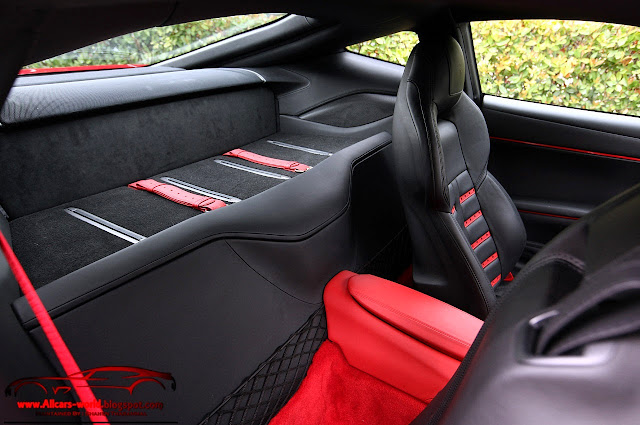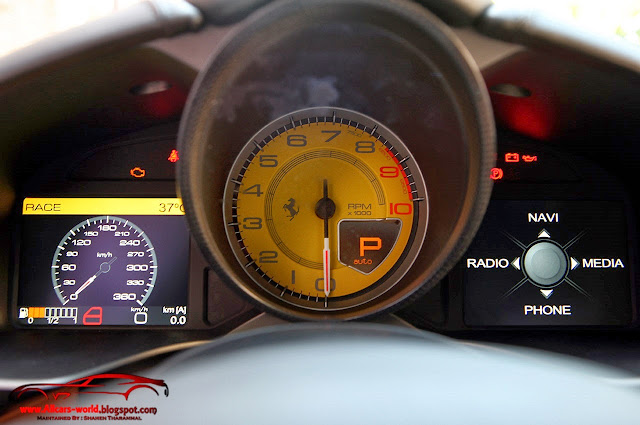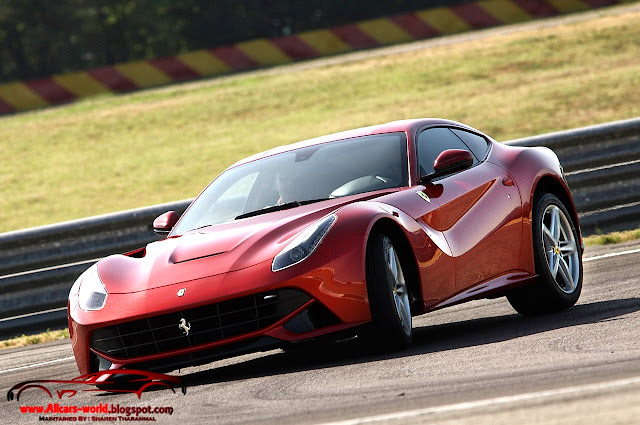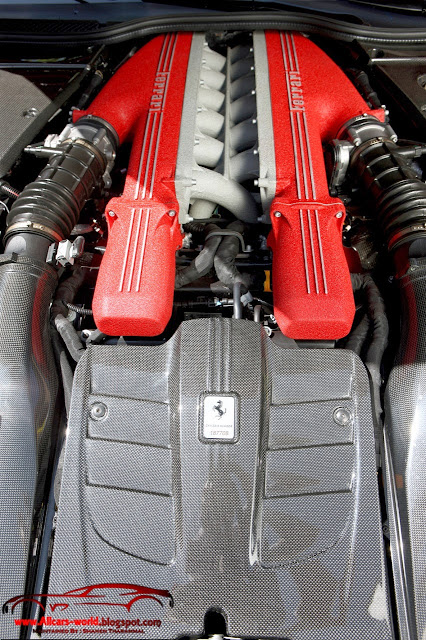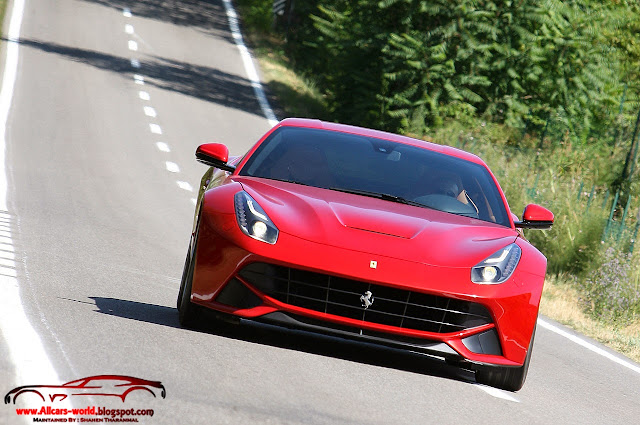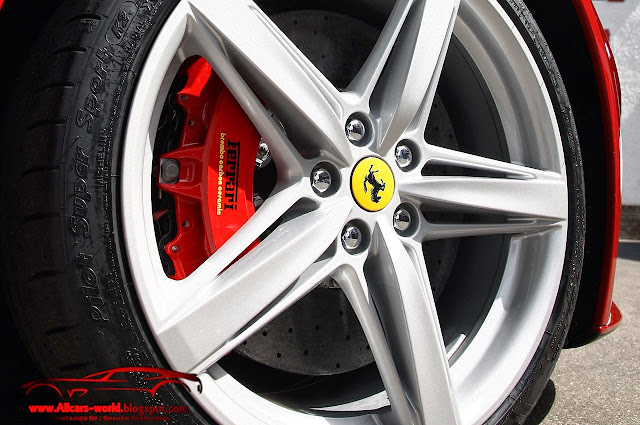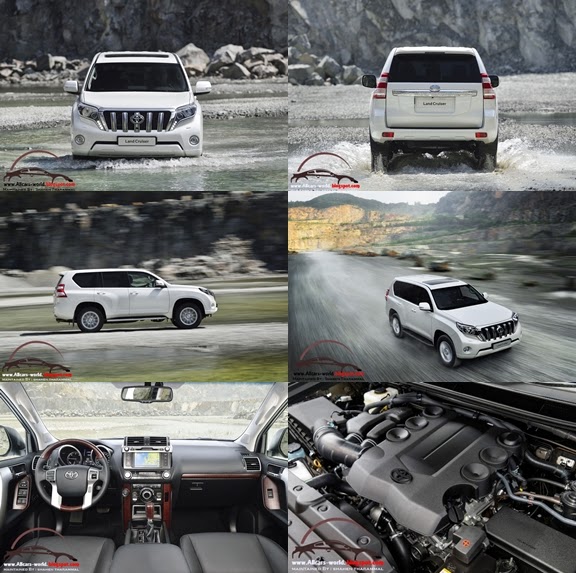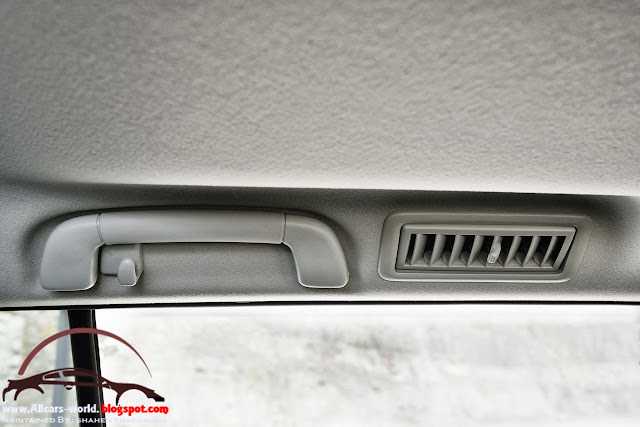FULL IMAGES...CLICK HERE >>> http://www.pinterest.com/Automotivenews/2013-ferrari-f12berlinetta/
PRICE : For 2013 Ferrari F12berlinetta $315,888
The 2013 Ferrari F12berlinetta ushers in a new generation of Ferrari 12-cylinders in the form of a car that delivers unprecedented performance from an exceptional new engine, unparalleled handling and innovative design and aerodynamics.
Every time Ferrari has unveiled a new 12-cylinder sports car since 1947, something magical has happened. Perhaps this has to do with the fact that our very first car, the 125 S, was itself a 12-cylinder or maybe it's because purists see the 12-cylinder as the engine size par excellence. Be that as it may, every time a Prancing Horse car of this kind makes its debut, it hails the start of a new era. There have been several 12-cylinder models built here at Maranello that have gone down in the annals of automotive history because of their technological prowess and the results they've delivered. The 1953 375 America, for instance, had an engine derived directly from the F1 single-seater of the day, while the 250 GTO in the 1960s was the perfect melding of styling and performance. That list must also include, of course, the 1969 365 GTB4, better known simply as the Daytona, which, thanks to its brilliantly balanced architecture delivered absolutely unique driving emotions. All of these engines and cars are now eagerly sought after by collectors the world over and each one represented major generational leap forward when it debuted.
This story continues today with the Ferrari F12berlinetta which is not merely our latest mid-front 12-cylinder model but the first in a whole new generation of this kind of car. In fact, it is the most high performance Ferrari ever built yet it still effortlessly marries extreme performance with benchmark efficiency, delivering fuel consumption and emissions levels that are 30% lower than the previous generation. The challenge for our engineers and technicians this time was to create a front-engined car with blistering performance that was still able to offer the same driving pleasure and involvement at lower speeds. A difficult task because it meant improving on the design of the 599 GTB Fiorano, deemed the most beautiful Ferrari ever. However, their commitment and determination has produced a car sporting an exceptional new 740 hp mid-front V12 engine that delivers 690 Nm of torque.
Its engine and driver's seat have both been lowered, the wheelbase is shorter and a new suspension and gearbox layout have helped compact the rear. The result is a more compact car than the 599 GTB Fiorano. One that also has perfect weight distribution with 54% over the rear axle and a lower, pulled-back centre of gravity to boot. Thanks to all these characteristics, the Ferrari F12berlinetta delivers truly exceptional performance figures: 0-200 km/h in 8.5 seconds and a lap time at Fiorano of just 1'23". The Ferrari F12berlinetta's spaceframe chassis and bodyshell are both entirely new too and employ 12 different aluminium alloys - some being used for the first time in the automotive sector - and an array of leading-edge assembly and joining technologies.
This helped cut the car's overall weight to just 1,525 kg and maximise its performance efficiency, boosting torsional rigidity by 20%. As with every Ferrari, the F12berlinetta's aerodynamics were developed hand-in-glove with its styling, resulting in a plethora of innovative solutions. Not least of these are the Aero Bridge, which uses the car's bonnet to create downforce for the first time, and Active Brake Cooling, a system of guide vanes on the brake air ducts which open when brake operating temperatures are high enough. The result is that the Ferrari F12berlinetta is the most aerodynamically efficient Ferrari ever (a figure of 1.12 - double that of the 599 GTB Fiorano) with a Cd of 0.299 and downforce of 123 kg at 200 km/h.
The product of the ongoing collaboration between the Ferrari Style Centre and Pininfarina, the Ferrari F12berlinetta's design centres around the car's brilliantly bilance proportions. It has an original innovative style featuring typical Ferrari 12-cylinder styling cues. Clothed in sleek, aggressively sculpted lines, it offers a superb standard of occupant space and comfort despite its compact exterior dimensions too.
EXTERIOR
Up front, you get this bold combination of style and aggression that is enough to make even the most experienced driver a little uneasy. The thin lower lip leads you up to a sinister looking grin that the lower grille creates which almost looks like it is daring you to hop into the driver’s seat and take it for a spin, if you can handle it. The twin horizontal bras of the grill are intersected by a quintuplet of vertical bars, giving this grin a full set of teeth. Flanking the grille are two air-intake vents that electronically open and close to allow cooling air to flow over the front brakes, as needed.
The projector headlights sit inside lenses that seem to be one with the body, seamlessly flowing rearward to allow air to just slip off of the body, which is evident by the F12berlinetta’s 0.299 drag coefficient. Making up the outer edge of these sleek headlight assemblies is a line of LED lights, giving it a little extra flare.
Though the styling of the F12berlinetta may simply look like a work of art, there is a lot more science behind this artwork than you may know. The stylish and swooping hood actually does more than just catch your eye; it also catches the wind and creates massive down-force. The hood flanks are tall enough to channel air toward the center of the hood, creating this down-force and the air is then channeled through a pair of openings on either edge of the hood, near the windshield. This is a technology that Ferrari calls the Aero Bridge.
As the air escapes from these two vents at the rear of the hood, it is channeled into the valley cut into the doors. The valley then swoops around the car as you approach the rear end of the F12berlinetta.
Helping improve its aerodynamic drag and down-force production, Ferrari faired in the underside of the F12berlinetta – closed the underside off, so it is one smooth piece. This allows the air to flow under the car without creating excessive upward pressure or wind resistance. As the airflow approaches the rear of the fairing, it is redirected upward and out of the vents just in front of the rear wheels. This rush of air creates a large amount of down-force on the rear axle without increasing aerodynamic drag too much.
From that point, the remaining air flows under the center of the faired underside of the F12berlinetta and hits the rear diffuser to create the remaining down-force and reduce drag. In all, the body design of the F12berlinetta creates a total of 123 kg (271 lbs) of down-force without the use of any additional spoilers beyond the rear diffuser. That’s quite an impressive feat to say the least.
The overall focus of the F12berlinetta was to take what Ferrari had built with the 599 GTB and make it better. Ferrari achieved this by dropping 70 kg (154 lbs) of weight from the 599 GTB, mostly from the areas that hang over the edges of the wheelbase. This is exactly why so much focus went into effective use of airflow, as Ferrari didn’t need to add extra weight to the body in the form of spoilers. That knocks off most of the weight right there.
Ferrari also knocked 47 mm (1.85 inches) in length, 63 mm (2.48 inches) in length and 20 mm (0.787 inches) in width from the 599 GTB’s dimensions. In order to meet the aerodynamic needs, you’ll also notice that Ferrari took the 599 GTB’s front glass and raked it rearward at a shallower angle and lowered the roofline significantly. The rear section is also significantly shorter on the F12berlinetta, as it only has 82 mm (3.22 inches) of overhang from the rearmost part of the wheelbase. All of this reduction and 12 different aluminum alloys that make up the body brings the F12berlinetta down to a svelte 1,525 kg (3,362 lbs).
Aerodynamics isn’t all the Ferrari was looking for though, which is noticeable as we approach the backside of the car. This collaboration between Ferrari design and Pininfarina Pininfarina nets us a Kammback-inspired rear end – Kamm is a famed aerodynamicist that used abruptly cut-off rear ends to help with reducing drag – that integrates with the rear spoiler.
Around the back end you also get a unique “T” shape that starts at the center of the lower, rear fascia and wraps around the dual circular LED taillights. Flanking the base of the “T” is a pair of dual exhaust exits, giving the F12berlinetta a total of four exhaust escapes.
Just imagining the thought process and ingenuity that went into designing the F12berlinetta to be both beautiful and functional is mind boggling. As per usual, Ferrari out shined Lamborghini in body form, fit, and function, but there is more to a supercar than just its looks, so let’s continue onto the interior.
INTERIOR
Unlike the overwhelming interior of the Aventador, the F12berlinetta gives you a clean look and feel that takes you into the world of racing where only the important buttons and gauges are displayed. The steering wheel is devoid of buttons that are unnecessary and the paddle shifters are in the perfect position behind the wheel to make shifting through the gears a seamless venture.
Even the air vents underwent some serious designing, as they are elegantly crafted from carbon fiber and aluminum alloy, giving the interior a little something extra that you may be missing in other supercars. The center console or center tunnel as Ferrari calls it, is not very overwhelming and has only the necessary components attached to it, like the gear selector, and hazard warning buttons.
The simplistic F12berlinetta interior continues to the door panel where everything just seems to flow with absoluter perfection. The armrest, door handle, tweeter, speaker, airbag and leather pocket all fluidly travel together along the panel, making it look as if they are all one piece. You can opt for your own addition to the door panels by adding in special touches, like aluminum borders underlining the panel’s already stellar lines.
The steering wheel looks as if it belongs in an art museum, as Ferrari managed to capture the essence of a racing steering wheel with the elegance of a luxury car. The focal point of the wheel is to give the driver perfect hand position, allowing for optimal grip, but it also features just enough control buttons to handle some of the car’s more important features. On the right side of the wheel, you have all of your technical goody controls, like the controls for the TFT infotainment screen, satellite navigation, stereo with Bluetooth streaming, and voice-activated audio controls. On the left side, you get all of you get-up-and-go controls, as it handles the Vehicle Dynamic Assistance functions, like: car status, potential performance, changing between RACE, CT-off and ESC-off modes, and other features.
The seats were carefully designed to offer maximum comfort while using minimal padding to make the most efficient use of the reduced cabin space in the F12berlinetta. The seats have great lateral support, and keep you stuck into place while you caress the corners in this machine. In addition to their support, integrated headrests give you more support and a sportier feel as you drive. Even with its reduced space, a person up to 6’4” can sit in the cabin comfortably and it holds up to 500 liters (17.65 cubic-feet) of luggage with its rear bench folded down.
The delicate ballet of mixing beauty and sport is a thing rarely achieved, but Ferrari did so with the F12berlinetta’s cockpit. It has the cleanliness that we all desire, but the options and controls that the modern age requires. What an impressive piece of machinery this car is becoming.
POWERTRAIN
Driving involvement is intensified by the rich, full exhaust soundtrack typical of Ferrari'snaturally-aspirated V12s. The Ferrari F12berlinetta's performance levels give a good idea of the engine's incredible efficiency, where both fuel consumption and emissions are now 30 per cent lower thanks to the Stop&Start system, a "smart" alternator, and Multispark ignition system. These, along with numerous other technical solutions, have reduced internal friction making the F12berlinetta best-in-class for its power-emissions ratio.
The car's compression ratio has also been increased to 13.5:1 and a new 3.0 ECU has been adopted that uses ionisation currents to control sparking and detect misfires. The Multispark ignition generates three sparks of different durations and intensities in quick succession. At low engine speeds, this optimises combustion and, consequently, lowers fuel consumption. The engine is also equipped with Stop&Start and a "smart" alternator which recharges the battery only when there is no demand for power. Meticulous attention was also paid to reducing internal friction, exhaust backpressure and intake depressurisation.
The cylinder block has four oil scavenge pumps with rotors using smaller diameter blades which optimise extraction efficiency. Lubrication is guaranteed by an engine oil pump with variable geometry. The design of the pistons includes an anodising treatment to the first piston groove, with PVD (Physical Vapour Deposition) coating on the first piston ring and Graphal-coated piston skirts. All of this reduces friction between the piston and the cylinder liner. The camshafts are super-finished using a lapping process that reduces surface roughness to under 0.05 Ra, thus minimising the coefficient of friction between the cam lobes and the tappets. The tappets themselves have been given a DLC (Diamond Like Carbon) coating that reduces their coefficient of friction, increasing performance and reducing fuel consumption.
The cylinder head features different conduit designs, new intake manifolds and new plenums fitted with resonators. The resonators create overpressure inside the intake tract the moment the intake valve opens and immediately before it closes, guaranteeing improved cylinder filling and generating a powerful supercharging effect which increases engine performance. The whole exhaust sequence has also been optimised - the catalysers have been miniaturised and hydroformed manifolds have been adopted, reducing their form and size without impinging on their capacity, resulting in improved permeability and reduced backpressure. The system's geometry and materials have been developed to harmonise the intake and exhaust soundtracks to underscore the car's extremely sporty character. All of the pipes connecting the 6-in-1 exhaust manifold to the single catalyser per bank are of equal length and this optimises the sound giving predominance to the first-order combustion harmonics. The characteristic engine sound can clearly be heard in the cockpit in all driving conditions.
The seven-speed F1 dual-clutch transmission boosts both performance and ride comfort at once. The technology involved is based on the independent management of odd and even gears which are pre-selected using two different in-put shafts. Gear shifting time - calculated as the overlap between the opening and closing phases of the two clutches - is thus zero and there is no interruption of torque delivery to the wheels. Shortened ratios have been developed for the Ferrari F12berlinetta and 7th gear is a direct ratio, not an overdrive, to ensure that the car's huge performance potential can be exploited in every gear. The E-Diff3 electronic differential has also been integrated into the gearbox, helping to cut the car's overall weight.
DESIGN
To achieve these objectives, the engineers lowered the engine, dashboard and seats. Furthermore the rear of the car is now more compact, thanks to the repositioning and reduction in size of the fuel tank (permitted in part by a more efficient engine which delivers the same range as before) and to the new transaxle layout allowed by the rear multi-link suspension and F1 dual-clutch transmission with integrated electronic differential. Rather than a traditional separate boot, the F12berlinetta features a generous tail-gate incorporating the rear screen which contributes both to the compactness of the design, and the generous luggage space and its accessibility, while ensuring maximum structural rigidity.
This solution also ensures that more of the car's mass sits inside the shorter wheelbase to the benefit of handling dynamics. The end result is a car that's lighter by 70 kg with a centre of gravity that's 25 mm lower. It's also shorter (-47mm), lower (-63 mm) and narrower (-20 mm) compared to the previous V12 coupé. The rear overhang has been greatly reduced (-82 mm) while the front one has been estende (+65 mm) to accommodate the cooling systems required for the powerful V12 engine. Weight distribution is ideal - 54% at the rear - and is unmatched by competitors within the segment.
AERODYNAMICS
The Ferrari F12berlinetta's aerodynamic efficiency brass is mostly generated by three elements: the Aero Bridge, the Blown Spoiler, the aerodynamic underbody. The Aero Bridge is an innovative solution that uses the bonnet to create downforce for the first time. It does so by availing of an aerodynamic channel on each side. These pass below a bridge in the area between the front wheelarch and the bottom of the A-pillar and deflect the airflow into scoops in the flanks where it interacts with the wake from the wheel wells to decrease drag. The Blown Spoiler uses the air flows near the rear of the car to modify, via special intakes, the pressure field in the wheel well, boosting overall efficiency. Lastly, the car's flat underbody has been greatly evolved, not least thanks to the fact that the front splitter which is now separate to the bumper. This generates downforce whilst simultaneously directing the air flows towards the rear extractor, improving efficiency.
Aerodynamic dams and semi-cone diffusers have been placed ahead of the front wheels which, as well as generating downforce, also help cool the brakes. The rear dam has the dual role of directing the airflow away from the wheel and generating a vortex that isolates the underbody from the centrifugal forces caused by the movement of the rear wheels. The generous rear diffuser, has four fins, the middle two of which have vortex generators, and thus also contributes to the significant increase in downforce. When it comes to integrating fluid dynamics and thermal management, the central air vent on the bonnet boosts the efficiency of the cooling system and also helps lessen the impact of the air on the windscreen at high speeds, creating a cushion that deflects the natural air flow. Drag is also reduced by the Active Brake Cooling system of guide vanes on the brake air ducts which open only if brake operating temperatures are high enough.
STYLE
The front of the car is dominated by an imposing grille that draws air into the engine bay to cool the V12. On either side of it are electronically-controlled guide vanes which help cool the brakes. This is an original, active aerodynamic solution as, when closed, they cut drag and, when open, guarantee optimal brake cooling. The rear of the Ferrari F12berlinetta is characterised by a modern, functional reinterpretation of the Kamm tail which seamlessly integrates the two vertical fences of the rear diffuser. The resulting original T-shape also incorporates two full-LED circular tail-lights and the clearly F1-inspired rear fog light.
DYNAMIC & PERFORMANCE
With a Fiorano lap time of just 1'23", 0-100 km/h acceleration in 3.1 seconds and 0 to 200 km/h in 8.5 seconds, the Ferrari F12berlinetta is the most high-performance car in Ferrari history. On top of pure performance figures, however, it is also incredibly fluid and intuitive to drive, thanks to its unique handling which inspires confidence at all speeds, not just on the limit on the track. This was achieved thanks in great part to the development work carried out on the layout which has helped the car take a massive leap forward in terms of agility and responsiveness, even at slower speeds, a characteristic more in keeping with mid-rear-engined cars until now. In addition to this, however, all the car's sub-systems were developed and integrated with each other specifically to achieve these goals without compromising on high standards of occupant comfort. The latter include springs and dampers, wheels and tyres, yaw control systems, such as the E-Diff, traction control (F1-Trac), Stability Control (ESC), and auxiliary braking systems, such as ABS/EBD, which work in coordination to transfer torque in the most intelligent and efficient way possible to get the most out of the performance available.
The new carbon-ceramic braking system (CCM3) benefits from the latest developments, including a new material mix for the rear pads and an optimised cooling system derived from Ferrari's F1 experience, along with the Active Brake Cooling at the front. Combined, these improvements eliminate fade and deliver excellent stopping distances (131 m from 200 km/h, an impressive 7-metre improvement on the 599 GTB Fiorano).
The Ferrari F12berlinetta features traditional double wishbone suspension with lower L-arm at the front and multi-link at the rear. It also sports the new SCM-E magnetorheological dampers which have twin solenoids and a new ECU with upgraded software. The system uses a fluid whose viscosity is altered by an electronically-controlled magnetic field generated inside the damper. This in turn translates into faster response times and more precise bump control which improves both performance and ride comfort. The F12berlinetta thus has faster acceleration than any other road-going Ferrari. Benchmark performance is marche by outstanding driver involvement courtesy of later braking, quicker turn-in, higher entry speeds and greater lateral acceleration through bends. The car requie less steering input at the wheel during cornering, there is better traction accelerating out of bends and braking distances are drastically reduced too.
Okay, while the F12berlinetta is a gorgeous piece of art inside and out, we need to have a look at what makes a supercar really super. In other words, we need to see what’s moving this machine. Under the hood, you have a 6,262 cc, 65-degree V-12 engine fed by a 200-bar (2,900 psi) direct-injection system. Putting that into perspective, the direct injection system in the F12berlinetta produces 57 times the pressure of your standard fuel-injection system.
This allows this naturally-aspirated engine to pump out 740 CV (729 horsepower) at 8,250 rpm, which equals out to 118 CV (116 horsepower) per liter. Horsepower is not the only thing that you need to take into account when looking at a supercar, as torque is what gets this beast moving in the first place and the F12berlinetta has plenty. It produces a face-shifting 690 Nm (508 pound-feet) of torque at 6,000 rpm and 552 Nm (406 pound-feet) of that is available from 2,500 rpm
Ferrari balanced out the F12berlinetta’s engine perfectly and kept its rolling resistance low, so that it can reach its peak engine speeds in rapid for. This is an oft-overlooked benefit, as what’s the point of having massive amounts of horsepower, when you can barely get the heavy engine components spinning fast enough to reach the peak power?
To boot, Ferrari also put an added focus on fuel economy and emissions, by increasing the V-12’s combined fuel economy to 15 liters per 100 km (15 mpg) and bringing its emissions down to 350 grams per kilometer. While neither specification is stellar when compared to the average cars of the world, those are very impressive in the supercar world.
This masterfully crafted engine connects to an F1-style transmission, which tosses power to the rear wheels. This transmission is a dual-clutch variety that instantaneously switches gears, thus eliminating the need for you to row your own gears.
This dual-clutch 7-speed transmission is specially tuned to handle the engine’s power and driving characteristics. To add a little extra to the pot, Ferrari added in its electronic E-diff which helps reduce the overall weight of the driveline.
This perfect marriage of power and efficiency is enough to get the F12berlinetta to 100 km/h (62 mph) in just 3.1 seconds, dropping it in at 60 mph in just about 3 seconds flat. It can also reach 200 km/h (124 mph) in only 8.5 seconds. It also gives the F12 a top speed of over 211 mph.
Overall, we have some real impressive numbers from the F12berlinetta, but we need to get a good look at the platform this stellar car rides on to make sure it can actually handle all of this power.
The new carbon-ceramic braking system (CCM3) benefits from the latest developments, including a new material mix for the rear pads and an optimised cooling system derived from Ferrari's F1 experience, along with the Active Brake Cooling at the front. Combined, these improvements eliminate fade and deliver excellent stopping distances (131 m from 200 km/h, an impressive 7-metre improvement on the 599 GTB Fiorano).
The Ferrari F12berlinetta features traditional double wishbone suspension with lower L-arm at the front and multi-link at the rear. It also sports the new SCM-E magnetorheological dampers which have twin solenoids and a new ECU with upgraded software. The system uses a fluid whose viscosity is altered by an electronically-controlled magnetic field generated inside the damper. This in turn translates into faster response times and more precise bump control which improves both performance and ride comfort. The F12berlinetta thus has faster acceleration than any other road-going Ferrari. Benchmark performance is marche by outstanding driver involvement courtesy of later braking, quicker turn-in, higher entry speeds and greater lateral acceleration through bends. The car requie less steering input at the wheel during cornering, there is better traction accelerating out of bends and braking distances are drastically reduced too.
ENGINE & DRIVETRAIN
This allows this naturally-aspirated engine to pump out 740 CV (729 horsepower) at 8,250 rpm, which equals out to 118 CV (116 horsepower) per liter. Horsepower is not the only thing that you need to take into account when looking at a supercar, as torque is what gets this beast moving in the first place and the F12berlinetta has plenty. It produces a face-shifting 690 Nm (508 pound-feet) of torque at 6,000 rpm and 552 Nm (406 pound-feet) of that is available from 2,500 rpm
Ferrari balanced out the F12berlinetta’s engine perfectly and kept its rolling resistance low, so that it can reach its peak engine speeds in rapid for. This is an oft-overlooked benefit, as what’s the point of having massive amounts of horsepower, when you can barely get the heavy engine components spinning fast enough to reach the peak power?
To boot, Ferrari also put an added focus on fuel economy and emissions, by increasing the V-12’s combined fuel economy to 15 liters per 100 km (15 mpg) and bringing its emissions down to 350 grams per kilometer. While neither specification is stellar when compared to the average cars of the world, those are very impressive in the supercar world.
This masterfully crafted engine connects to an F1-style transmission, which tosses power to the rear wheels. This transmission is a dual-clutch variety that instantaneously switches gears, thus eliminating the need for you to row your own gears.
This dual-clutch 7-speed transmission is specially tuned to handle the engine’s power and driving characteristics. To add a little extra to the pot, Ferrari added in its electronic E-diff which helps reduce the overall weight of the driveline.
This perfect marriage of power and efficiency is enough to get the F12berlinetta to 100 km/h (62 mph) in just 3.1 seconds, dropping it in at 60 mph in just about 3 seconds flat. It can also reach 200 km/h (124 mph) in only 8.5 seconds. It also gives the F12 a top speed of over 211 mph.
Overall, we have some real impressive numbers from the F12berlinetta, but we need to get a good look at the platform this stellar car rides on to make sure it can actually handle all of this power.
CHASSIS & SUSPENSION
So we know that the F12berlinetta can go fast, looks style, and is a relatively comfortable car, but how does it handle? Being a front-engine, rear-drive car immediately puts the F12berlinetta at a disadvantage, but Ferrari worked hard to overcome that downfall. Its traditional double-wishbone suspension with lower L-arm is pretty common in the supercar world, and the multi-link suspension on the rear is common throughout the automotive world. Where Ferrari made its mark is in its new SCM-E magnetetorheological dampers.
This SCM-E system uses fluid that is altered by an electronically controlled magnetic field inside its bump damper. This allows the F12berlinetta to quickly adjust the dampers for the specific situation you are in. If you are driving at slow speeds and encountering a lot of bumps, the dampers soften, allowing you to have a more comfortable ride. If you suddenly have to make a quick maneuver or are driving at a high rate of speed, the dampers stiffen, giving you quicker response.
With its lighter body and shorter wheelbase, you can also come into a turn much faster than its heavier predecessor and exit out of the turn at heavier throttle. To help you in the twist, Ferrari Ferrari also fitted the F12berlinetta with an E-Diff, F1-Trac traction control, electronic stability control, yaw control, ABS, EBD, and 255/35ZR20 tires on the front and 315/35ZR20 tires on the rear. You can even switch over to 305/35ZR20 tires in the winter time and add on a set of chains – yeah, a Ferrari with snow chains, what an image.
The F12berlinetta also boasts an all-new carbon-ceramic braking system (CCM3). This includes all new material mix on the rear ads and an electronically controlled cooling system for the fronts. The front rotors measure in at 15.7 inches and the rears measure in at 14.2 inches, giving the F12berlinetta a 131-meter (429 foot) stopping distance from 200 km/h (124 mph), a 7-meter stopping advantage over the 599 GTB.
Lastly, Ferrari worked on making the entire structure of the F12berlinetta 20 percent stronger and rigid than the 599 GTB, using its careful blends of aluminum alloys – some of which are being used on a car for the first time ever. This helps keep the body from twisting in the corner, keeping it firmly planted on the road.
Overall, this Ferrari is built like a racecar with street car comfort, and the suspension certainly ties it all together. We are still awaiting some official testing results on the slalom and the skid pad, but we are certain it will perform admirably.
PERSONALISATION PROGRAMME
Every Ferrari is unique, not just in terms of its performance, standard of technological innovation, and driver involvement and emotions, but also because of the virtually endless array of personalisation opportunities made available to it. Every single car that leaves Maranello, in fact, is tailored to a greater or lesser extent around the tastes and needs of its individual owner. Ferrari's rich and varied catalogue of content allows clients to personalise their cars along four main themes:
► Exterior and Colours :- offers a vast choice of ways to personalise the exterior of your car, starting with the two new paintwork colours, Rosso Berlinetta and Aluminium, created specifically to enhance the Ferrari F12berlinetta's aerodynamic forms. There are also 16 standard range colours and 10 historic ones to choose from. Sporty finishes for various details such as the front spoiler, sill covers and wing mirrors are available too as are three different wheel rim colours which can be combined with coloured brake calipers and carbon-fibre hubcaps;
► Interiors and Materials :- allows you to configure even the tiniest cabin detail to your own tastes. A huge array of luxury leathers, also available in sophisticated two-tone combinations, can be used to recreate whatever atmosphere you desire for the cabin. Technical fabrics and Alcantara can be used too to highlight contrasts. Even the stitching can be personalised in terms of colour, type and size to add an extra touch of elegance to the latter combinations. Our range of seats spans three instantly recognisable upholstery types: Ferrari tradition is ably represented by the Daytona and Diamond-Stitched versions which flank the sophisticated modern good looks of the new Leaf seats which have a characteristic leaf stitch pattern;
► Racing and Track :- is designed to lend your Ferrari F12berlinetta an even sportier élan as its options underscore the car's links with the racing world through signature features such as carbon-fibre spoilers, headlight trims and sill covers as well as new forged wheel rims and sporty tailpipes. This theme can also be continued inside the Ferrari F12berlinetta's cabin with the likes of carbon-fibre shell seats, new carbon-fibre dashboard inserts and other trim, and a carbon-fibre steering wheel with LEDs. However, the latter content not only enhances the Ferrari F12berlinetta's sporty character but also boosts its already-extreme performance by shaving more than 30 kg off its overall weight;
► Equipment and Travel :- contents are created to make the in-car experience more pleasurable for both driver and passenger, courtesy of such features as front and rear parking cameras, adaptive head lights and pneumatic jacks, all of which guarantee the driver maximum support in all driving conditions. JBL Professional has also developed the Ferrari F12berlinetta's new stereo system which has Quantum Logic and 12 speakers delivering a total of 1280 W. Combined with the new evolved emotional display, which now includes navigation data readouts, this makes the whole in-car experience even more unique and involving for the passenger.
The cutting-edge High Emotion Low Emissions package also provides further testament to Ferrari's commitment to the environment as it employs leading-edge emissions reduction technologies without impinging in the least on the superb driving pleasure and performance delivered by all Prancing Horse cars. Aside from the many, many catalogue options available, owners wishing to personalise their Ferrari F12berlinetta to an even more unique and exclusive standard can also avail of the Tailor Made programme. The latter offers a select group of clients a truly extensive selection of luxury fabrics, colours, original finishes and materials - some never used before in the automotive arena - to allow them literally tailor their car to their tastes like a bespoke suit. The result is a set of unique combinations inspired by the most iconic Ferraris and the racing world, and divided into three collections created specifically by the Style Centre: Classica, Scuderia and Inedita. Owners are flanked throughout the entire process of tailoring their bespoke car by a Personal Designer who will assist them in the choices and at every stage of the project's development until actual delivery.
VIDEO ( FULL FEATURES)
FULL IMAGES...CLICK HERE >>> http://www.pinterest.com/Automotivenews/2013-ferrari-f12berlinetta/
By : Automotive News & Super Modified Sports Cars
















